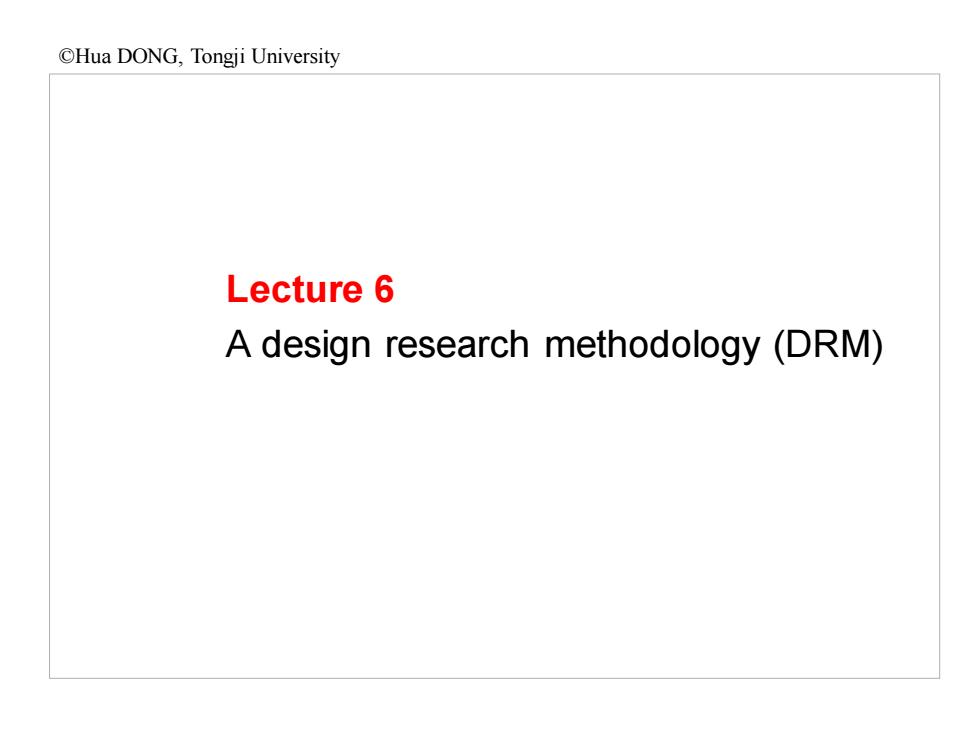
OHua DONG,Tongji University Lecture 6 A design research methodology(DRM)
Lecture 6 A design research methodology (DRM) ©Hua DONG, Tongji University
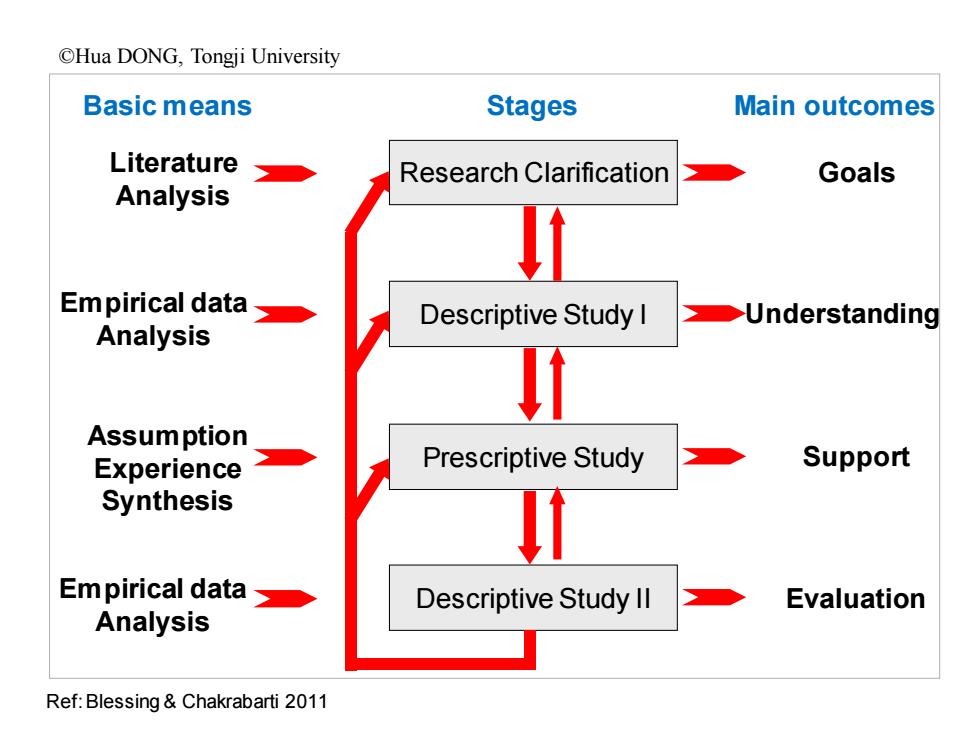
Hua DONG,Tongji University Basic means Stages Main outcomes Literature Research Clarification Goals Analysis Empirical data Descriptive Study I Understanding Analysis Assumption Experience Prescriptive Study Support Synthesis Empirical data Descriptive Study II Evaluation Analysis Ref:Blessing Chakrabarti 2011
Stages Research Clarification Descriptive Study I Prescriptive Study Descriptive Study II Main outcomes Goals Understanding Support Evaluation Basic means Literature Analysis Empirical data Analysis Assumption Experience Synthesis Empirical data Analysis Ref: Blessing & Chakrabarti 2011 ©Hua DONG, Tongji University
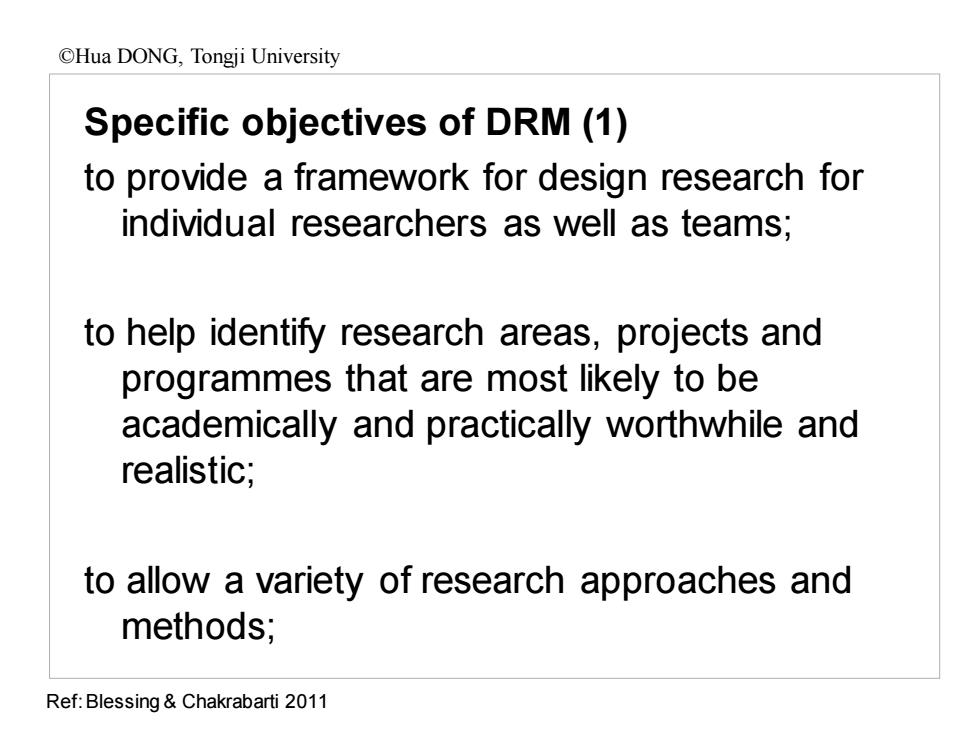
CHua DONG,Tongji University Specific objectives of DRM(1) to provide a framework for design research for individual researchers as well as teams; to help identify research areas,projects and programmes that are most likely to be academically and practically worthwhile and realistic; to allow a variety of research approaches and methods; Ref:Blessing Chakrabarti 2011
Specific objectives of DRM (1) to provide a framework for design research for individual researchers as well as teams; to help identify research areas, projects and programmes that are most likely to be academically and practically worthwhile and realistic; to allow a variety of research approaches and methods; Ref: Blessing & Chakrabarti 2011 ©Hua DONG, Tongji University
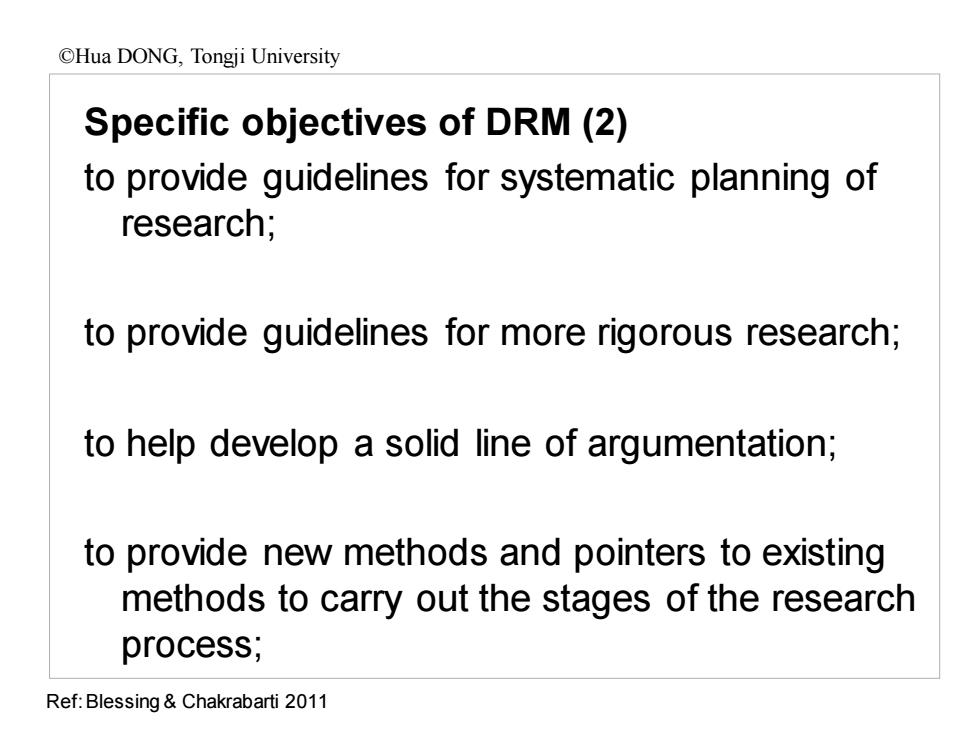
OHua DONG,Tongji University Specific objectives of DRM(2) to provide guidelines for systematic planning of research; to provide guidelines for more rigorous research; to help develop a solid line of argumentation; to provide new methods and pointers to existing methods to carry out the stages of the research process; Ref:Blessing Chakrabarti 2011
Specific objectives of DRM (2) to provide guidelines for systematic planning of research; to provide guidelines for more rigorous research; to help develop a solid line of argumentation; to provide new methods and pointers to existing methods to carry out the stages of the research process; Ref: Blessing & Chakrabarti 2011 ©Hua DONG, Tongji University
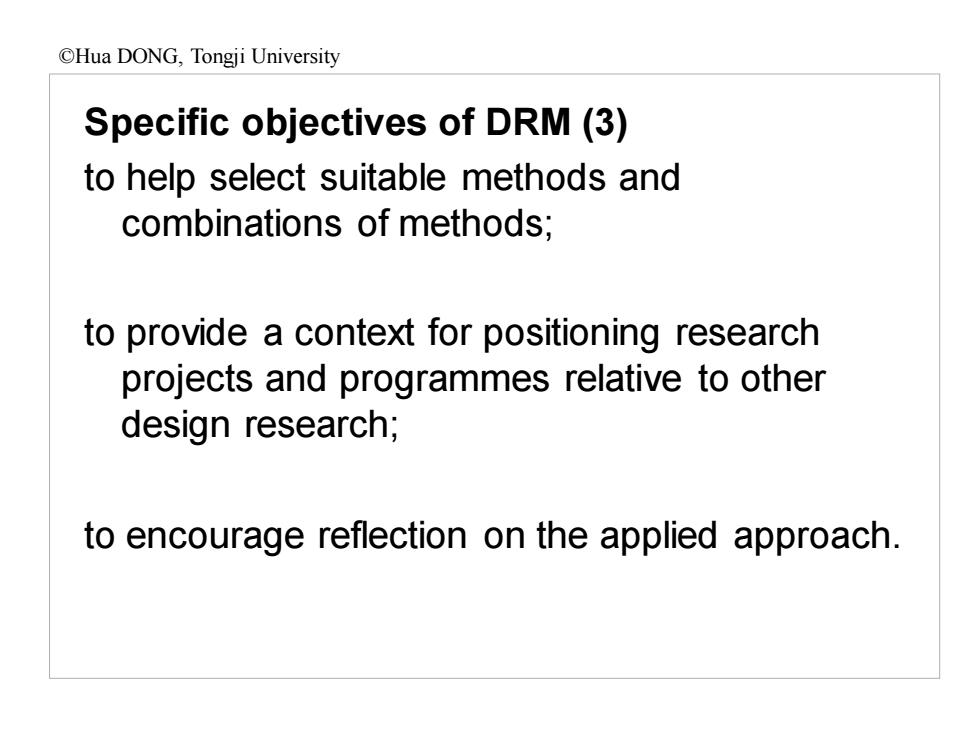
OHua DONG,Tongji University Specific objectives of DRM(3) to help select suitable methods and combinations of methods; to provide a context for positioning research projects and programmes relative to other design research; to encourage reflection on the applied approach
Specific objectives of DRM (3) to help select suitable methods and combinations of methods; to provide a context for positioning research projects and programmes relative to other design research; to encourage reflection on the applied approach. ©Hua DONG, Tongji University

Hua DONG,Tongji University Basic means Stanes Main outcomes Literature Research Clarification Goals Analysis Empirical data Descriptive Study I ●Understanding Analysis Assumption Experience Prescriptive Study Support Synthesis Empirical data Descriptive Study II Evaluation Analysis Ref:Blessing Chakrabarti 2011
Stages Research Clarification Descriptive Study I Prescriptive Study Descriptive Study II Main outcomes Goals Understanding Support Evaluation Basic means Literature Analysis Empirical data Analysis Assumption Experience Synthesis Empirical data Analysis Ref: Blessing & Chakrabarti 2011 ©Hua DONG, Tongji University
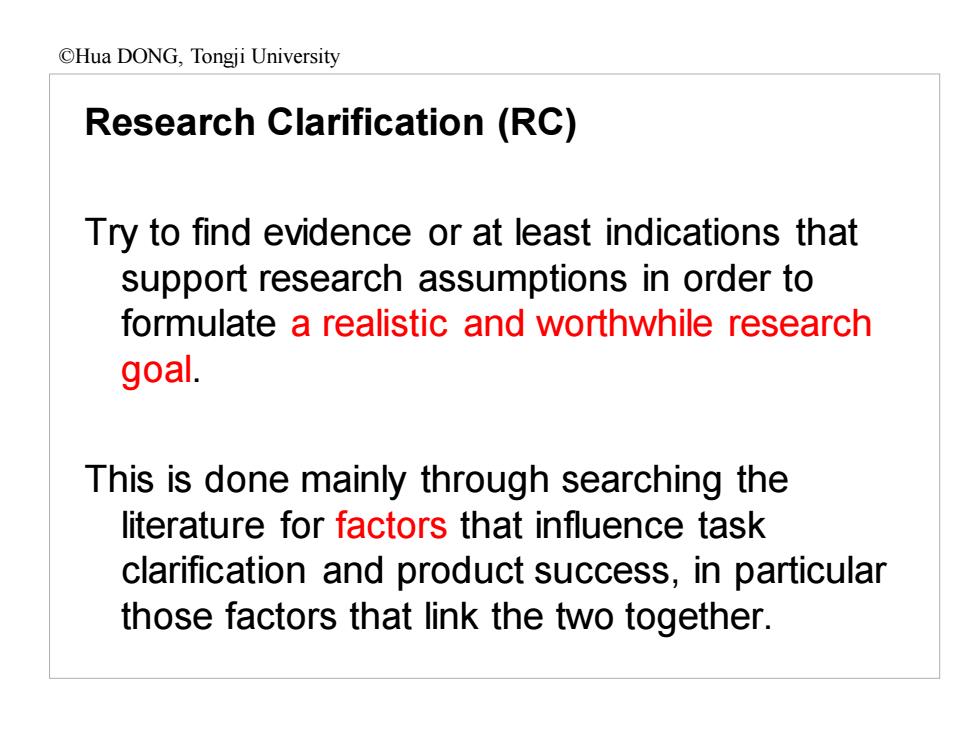
OHua DONG,Tongji University Research Clarification(RC) Try to find evidence or at least indications that support research assumptions in order to formulate a realistic and worthwhile research goal. This is done mainly through searching the literature for factors that influence task clarification and product success,in particular those factors that link the two together
Research Clarification (RC) Try to find evidence or at least indications that support research assumptions in order to formulate a realistic and worthwhile research goal. This is done mainly through searching the literature for factors that influence task clarification and product success, in particular those factors that link the two together. ©Hua DONG, Tongji University
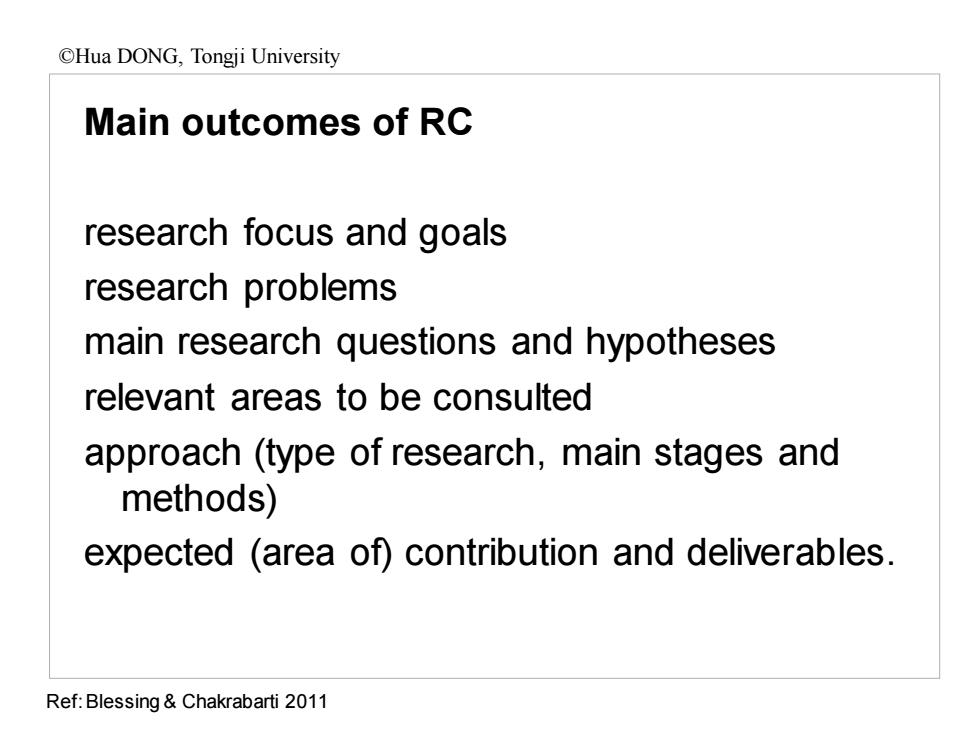
Hua DONG,Tongji University Main outcomes of RC research focus and goals research problems main research questions and hypotheses relevant areas to be consulted approach (type of research,main stages and methods) expected (area of)contribution and deliverables. Ref:Blessing Chakrabarti 2011
Main outcomes of RC research focus and goals research problems main research questions and hypotheses relevant areas to be consulted approach (type of research, main stages and methods) expected (area of) contribution and deliverables. Ref: Blessing & Chakrabarti 2011 ©Hua DONG, Tongji University
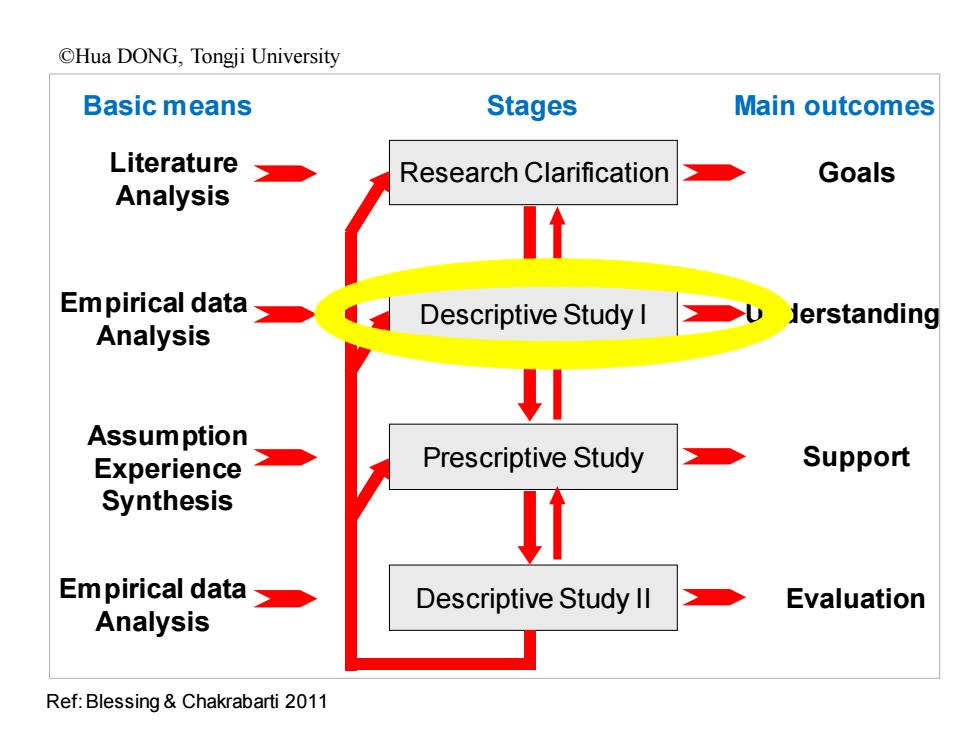
OHua DONG,Tongji University Basic means Stages Main outcomes Literature Research Clarification Goals Analysis Empirical data Descriptive Study I derstanding Analysis Assum ption Experience Prescriptive Study Support Synthesis Empirical data Descriptive Study Il Evaluation Analysis Ref:Blessing Chakrabarti 2011
Stages Research Clarification Descriptive Study I Prescriptive Study Descriptive Study II Main outcomes Goals Understanding Support Evaluation Basic means Literature Analysis Empirical data Analysis Assumption Experience Synthesis Empirical data Analysis Ref: Blessing & Chakrabarti 2011 ©Hua DONG, Tongji University

Hua DONG,Tongji University Descriptive Study I (DS Il) The intention is to make the description detailed enough to determine which factor(s)should be addressed to improve task clarification as effectively and efficiently as possible. Ref:Blessing Chakrabarti 2011
Descriptive Study I (DS II) The intention is to make the description detailed enough to determine which factor(s) should be addressed to improve task clarification as effectively and efficiently as possible. Ref: Blessing & Chakrabarti 2011 ©Hua DONG, Tongji University